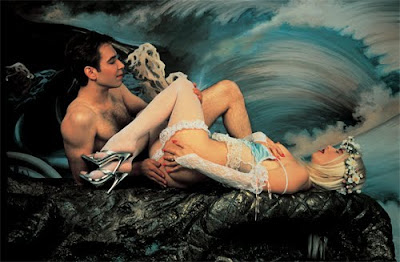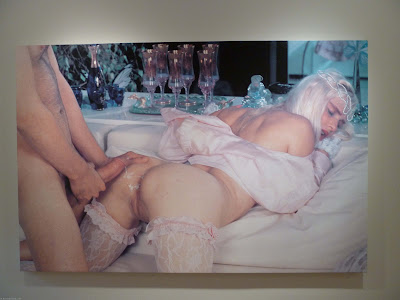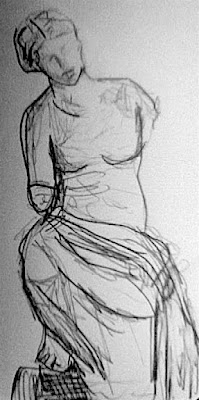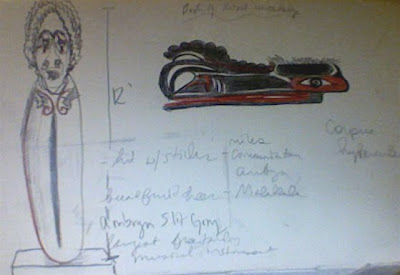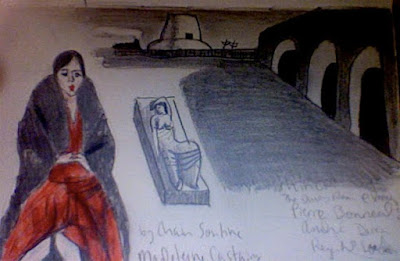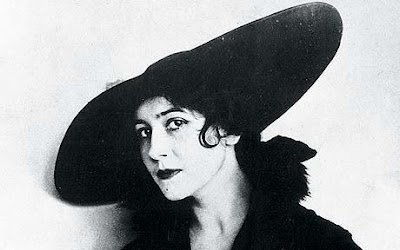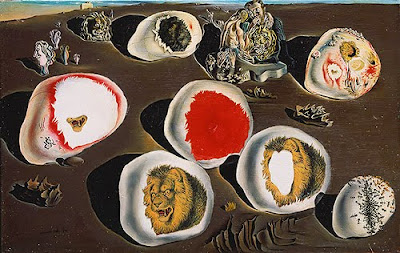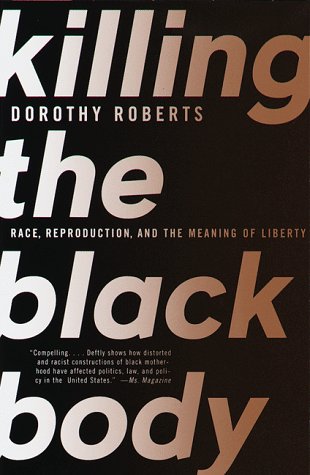So I was just browsing the internet like any college student with no immediate plans to do actual work and I came across a fabulous video/ game called "Jeff Koons Must Die." Now, normally hearing a title like that with any other name would shock me and set me immediately in the distasteful direction but because the clever designer feels the same way about Jeff Koons as me I could not leave it be.
Jeff Koons is an innovative man, he has ingenious ways of creating art. He is most famous for his Rabbit piece, a sculpture constructed out of cast aluminum but molded in a way that makes it look like it is actually a nearly weightless silver blown up balloon rabbit. He further cultivated that style and made an entire series using this technique with inflatable-seeming heavy metal pieces. The sculptures fool your perception as a viewer, often causing your mind to ignore the impossibility of the physics involved in a plastic blown up toy being used in such a manner. This is the creative method artistry that I appreciate in Jeff Koons's work.
HOWEVER, Jeff Koons is perhaps one of the most egotistical artists alive. His work has been dismissed as kitsch: crass and based on cynical self-merchandising. Koons has stated that there are no hidden meanings in his works, and to be honest anyone can tell that his art is very superficial especially after he married Hungarian-born naturalized-Italian pornography star Cicciolina (Ilona Staller). His Made in Heaven series of paintings, photographs, and sculptures portrayed the couple in explicit sexual positions and created quite the hubbub.
When I was living in London, I saw his Made in Heaven exhibit in the Tate Modern. The gallery room it was in was quite small, and it is important to mention that the photography pieces are quite large, approximately 8 feet x 12 feet. So imagine walking into a small room with a dozen extra large photographs taller and wider than you from Playboy splashing the walls and glass sculptures of people having sex on plynths throughout the room. Let me just say it was incredibly unpleasant being there and not in an artistic grotesquely handsome sort of way. I find his work crass, and jarring in the way seeing a PG snuff film would be.
If it makes you feel any better (it surely made me laugh to myself a bit) his face and his erect penis are never visible simultaneously in any of the photographs. I believe he had a body double. Hah!
Anyway, after all that... here's the videogame that I found which inspired me to write about Jeff Koons and his horrendous artwork:

Wednesday, March 30, 2011
Wednesday, March 23, 2011
Talented
I first heard about it while jogging on an elliptical in the fitness center, as I glanced at the televisions hanging over the treadmills. Reading the captions explaining her death, and her life of fame. What an incredible, beautiful... talented woman.
"George, my husband... George, who is out somewhere there in the dark, who is good to me - whom I revile, who can keep learning the games we play as quickly as I can change them. Who can make me happy and I do not wish to be happy. Yes, I do wish to be happy. George and Martha: Sad, sad, sad. Whom I will not forgive for having come to rest; for having seen me and having said: yes, this will do. " - Taylor as Martha in Who's Afraid of Virginia Woolf?
"George, my husband... George, who is out somewhere there in the dark, who is good to me - whom I revile, who can keep learning the games we play as quickly as I can change them. Who can make me happy and I do not wish to be happy. Yes, I do wish to be happy. George and Martha: Sad, sad, sad. Whom I will not forgive for having come to rest; for having seen me and having said: yes, this will do. " - Taylor as Martha in Who's Afraid of Virginia Woolf?
Sunday, March 20, 2011
Supermoon!
Last night we observed the Supermoon through Zack's telescope and he took a shot of the extra bright, extra close moon through the telescope's viewfinder.
CHECK THIS OUT:
CHECK THIS OUT:
Friday, March 18, 2011
Instead of celebrating St. Patties day like everyone else and getting drunk/setting the Irish back even further... I went to the Met!
Today I went to the Metropolitan Museum of Art! Though I went here years ago with a group from Skidmore's APA Program, this is really my first time actually going to the Met because I was literally stuck inside the American Wing for about 2 hours and could not find my way out - when I didn't even want to be there to begin with! Oy gevalt. However, this trip was a major success. In about two hours my boyfriend and I managed to get through 4 sections: The Greek and Roman Art, Modern & Contemporary Art, Arts of Africa/Oceania/the Americas, and the current special exhibit Cézanne's The Players. Whew!
We were surprised to see a banner above the entrance to the Met announcing their exhibit of Cézanne's painting The Players because I was carrying my molskin which has a quickly drawn colored pencil sketch of that very piece. I never remember to bring a sketchbook into a museum, what luck! Anyway, I documented some of the more notable pieces with on-site doodlings. Not necessarily the most prolific works, but some that I could quickly draw or thought might be fun to capture or was particularly drawn to (pun intended).
Cézanne's The Players Exhibit:
“Today everything is changing, but not for me,” Cézanne said. “I live in my hometown, and I rediscover the past in the faces of people my age.”
Cézanne is my favorite artist. He captures a certain liveliness in all of his paintings that is exciting to explore. His still life paintings come to life, and with his technique of using an interesting take on perspective. People have two eyes and therefore possess binocular vision. This gives rise to two slightly separate visual perceptions, which are simultaneously processed in the visual cortex of the brain. This provides people with depth perception and a complex knowledge of the space in which they inhabit. The essential aspect of binocular vision that Cézanne employed and which became influential on cubism, was that people often "see" two views of an object at the same time. This led him to paint with a varying outline that shows the left-eye and the right-eye view at the same time, thus ignoring traditional linear perspective. If this explanation is confusing, try focusing on an object and close one eye, then quickly close the other while opening the first eye. The object appears to jump slightly.
This exhibit focused on Cézanne's portraits of the working class, showing them playing cards or just sitting by the table. It is a handsome collection of the everyday scenes that display life in that era, similar to the writings of John Steinbeck.
I found a great review of the exhibit, check it out: www.nytimes.com/2011/02/11/arts/design/11cezanne.html
Artist: Adriaen van Ostade
Title: The Smiling Smoker aka: Peasant With A Pipe
Etching, 10.5 x 9.2 cm
Ostade was a Dutch Golden Age painter of genre works and his greatness lies in how often he caught the handsome side of the peasant class in spite of its grittier tendencies. This small etching caught one of the quieter moments of enjoyment, and the size alone draws the viewer in, literally, the only way to see the great detail found in the piece is to get right up in its grill. The piece feels very intimate, like he was wearing an invisibility cloak and just observed the peasant as he drew in his tobacco on a quiet evening. This was found in the special exhibit of Cézanne's The Players, which also had a lot of related works with similar subjects, often depictions of peasants.
The Greek and Roman Art Exhibit:
Greek, Parian marble
Height: 31 1/2 inches
450–440 b.c.
Grave stelai, like this one, would have been erected in Greek cemeteries in memory of the deceased. On this particular relief, a little girl bows her head with a seriousness unusual in someone so young. The gentle gravity of the child is beautifully expressed through her sweet farewell to her pet doves, her face is serene and strong. I felt like this peace had such a wonderful heart to it, despite the age of the materials and that it is made with marble. It is still remarkable to me how malleable marble seems to be in the hands of a skilled artist.
The stele was found in 1775 on the Greek island of Paros, one of the Cycladic Islands in the Aegean Sea. Many artists came to Athens at that time for employment and the sculptor of this grave monument could well have been among them.
I forgot to write down any information about this particular piece, but I thought that the figure was interesting. The gesture of the woman just looked beautiful and unique. I think her posture was what drew me in, the way she was sort of leaning to one side and her head was sort of shying away from the sky... not really something I identify with a dignified marble sculpture. Usually I think of the figures as epic characters expressing grandeur and divinity, not looking down which could be a pose of defeat.
Arts of Africa/Oceania/the Americas Exhibit:
Mask, approx. 3 feet long
Let me repeat... this is a mask. Neat, no? Okay, okay... I just forgot to write down the information about this piece, my bad.
Title: Ambryn Slit Gong
Height: 12 feet tall
The slit gong is one of the largest freestanding musical instruments ever created. The instrument is made from the bread fruit trees in Malakula. The Ambryn people hit the sides of the gong with sticks, and the sound produced was used for communication similar to a smoke signal because it can be heard miles away. I wonder what the cultural significance of the distorted human-like characteristics the head portion of the slit gong is. Maybe the creature represents a portion of the regional religion or something of that nature.
Book of Ritual Knowledge
Description: Open. Four accordian bound bark leaves, with magical texts in Batak script and illustrations of supernatural beings
This ancient text holds instructions for both benevolent and malevolent magic. Looking for a hex in a language you don't understand (a la The Mummy)?... This might be the book for you!
Modern & Contemporary Art Exhibit:
Artist: Dali
Title: Corpus Hypercubus
Corpus Hypercubus was painted in 1954 and depicts the crucified Jesus upon the net of a hypercube. Dali's wife Gala is the figure in the bottom left, almost admiring the crucified Jesus portrayed in Mary-esque garb (as my boyfriend just pointed out) with her clothing of blue, white, and gold. The scene is depicted in front of the bay in Port Lligat of Catalonia, Spain where Dali lived.
Artist: Chaim Soutine (French, born Lithuania, 1893–1943)
Title: Madeleine Castaing, 1929
Medium: Oil on canvas
Dimensions: 39 3/8 x 28 7/8 in.
Soutine introduced a lower vantage point, creating a greater distance between himself and the subject. Soutine brought out the characteristics of someone sophisticated, chic, cosmopolitan, yet vulnerable, which were enhanced by the palate but also the beautiful expressionistic brushwork full of texture and movement. What I love about this painting is Mme. Castaing's expression, it looks as if she has been in a car accident and her features have become a garbled mess but there is still an air of superiority and class with her pursed lips and unsettled eyebrows.
Madame Castaing was a prominent antiquarian and interior decorator in Paris for more than fifty years and is credited with introducing to France a new fashion for English eighteenth-century furniture. In 1927, the Castaings met Chaim Soutine at the time of his first exhibition. After the death of his dealer in 1932, the Castaings offered him support and protection.
I felt it was necessary to include an actual photograph of her, because the painting although beautiful captures more of her personality than her actual striking features.
Artist: Giorgio de Chirico (Italian (born Greece), Vólos 1888–1978 Rome)
Title: Ariadne
Date: 1913
Medium: Oil and graphite on canvas
Dimensions: 53 3/8 x 71 in.
"Ariadne" is part of a series of five paintings, all of 1913, in which the statue of Ariadne plays a major iconographic role. This statue is a Roman copy of a lost Hellenistic sculpture of Ariadne asleep on the island of Naxos, where she had been abandoned by Theseus. The sculpture of Ariadne had great symbolic meaning for de Chirico, perhaps evoking the classical past to which he had been exposed during his childhood in Greece.
This painting has a wonderful somber mood, carried heavily by the limited palate of ocher, deep brown, white, and green. The simplistic composition of the public square simplified into basic geometric shapes contributes as well.
Artist: Niles Spencer
Title: Erie Underpass
Date: 1949
Medium: Oil on canvas
Spencer's most characteristic subject was the urban scene, the factories, skyscrapers, bridges, warehouses, and dwellings of the city, constructed into simplified forms on the canvas. It was the abstract pattern of New York as a city rather than the life of its inhabitants that moved him. The absence of people in his pieces have the strength of understatement.
Artist: Giacometti
Medium: Iron/steel?
Dimensions: 18 inches long, approx.
Giacometti made this cat in memory of his brother's cat who "passed just like a ray of light", squeezing between close objects without never touching them. It was nice to see a cute cat sculpture in the museum. Mr. Wubbs could not be missed more at that point!
Artist Grant Wood (American, 1892–1942, Iowa City, Iowa)
Title: The Midnight Ride of Paul Revere
Date1931
Medium: Oil on Masonite
Dimensions: H. 30, W. 40 in.
Born and raised in Iowa, Grant Wood depicted ordinary life. Like other Regionalist painters, he rejected the abstract modernist trends of European art in an effort to forge a realistic style that could portray typically American subjects.
Wood first came to public attention in 1930, with his iconic painting "American Gothic." A year later he painted "The Ride of Paul Revere." The picture has a dreamlike sense of unreality, and almost look like a carefully constructed model village, especially with the bird's eye view perspective and almost a fish-eye composition. This is emphasized even more with the geometric shapes of the buildings and the landscape, notably the perfectly round treetops, and how the forms in the darker background are almost as clear in focus as those in the brightly lit foreground. Wood has heightened reality in the scene to make it almost otherworldly, displaying his uniqueness compared to other Regionalists of that time.
Artist: Salvador Dalí (Spanish, 1904–1989)
Title: The Accommodations of Desire, 1929
Medium: Oil and cut-and-pasted printed paper on cardboard
Dimensions: 8 3/4 x 13 3/4 in.
The Accommodations of Desire is a small gem that deals with the twenty-five-year-old Dalí's sexual anxieties over a love affair with an older, married woman. The woman, Gala, then the wife of Surrealist poet Paul Éluard, became Dalí's lifelong muse and mate. Dalí painted this after taking a walk alone with Gala. He included seven enlarged pebbles on which he envisioned what lay ahead for him, some of the images are considered to be Freudian in imagery: "terrorizing" lions' heads, as well as a toupee, various vessels, three figures embracing on a platform (a man, woman, and lion), and a colony of ants which symbolize decay. Interestingly the lions' heads are not painted, but actually cut-outs from a children's book that Dalí placed in the composition.
What I love about this painting is the emotional strife you feel just by looking at it; the way the lions' heads are cut and pasted and the brilliant reds suggest passionate disarray, while the whole scene gives off a vibe of frustrating desolation with the background of a desert. Again, with the smaller size the piece feels more personal because you cannot see the impeccable details unless your nose is nearly fogging up the glass. When I was viewing this I had the desire to learn a lot about Dalí's life, the common knowledge that his surreal paintings appear twisted and unsettling at times urges me to learn about any investigations about his psychological state of mind.
Perhaps I am just being inspired by the book I recently picked up, The Song Of Herself, an account of Frida Kahlo's life through previously unpublished interviews of the artist in which she analyzes her work and self. And for the record, it is a wonderful read so far!
Naturally, there were several more beautiful pieces I would have loved to do mini-research on, but that would leave you no mystery as to what you can find inside the Met for yourself.
We were surprised to see a banner above the entrance to the Met announcing their exhibit of Cézanne's painting The Players because I was carrying my molskin which has a quickly drawn colored pencil sketch of that very piece. I never remember to bring a sketchbook into a museum, what luck! Anyway, I documented some of the more notable pieces with on-site doodlings. Not necessarily the most prolific works, but some that I could quickly draw or thought might be fun to capture or was particularly drawn to (pun intended).
Cézanne's The Players Exhibit:
“Today everything is changing, but not for me,” Cézanne said. “I live in my hometown, and I rediscover the past in the faces of people my age.”
Cézanne is my favorite artist. He captures a certain liveliness in all of his paintings that is exciting to explore. His still life paintings come to life, and with his technique of using an interesting take on perspective. People have two eyes and therefore possess binocular vision. This gives rise to two slightly separate visual perceptions, which are simultaneously processed in the visual cortex of the brain. This provides people with depth perception and a complex knowledge of the space in which they inhabit. The essential aspect of binocular vision that Cézanne employed and which became influential on cubism, was that people often "see" two views of an object at the same time. This led him to paint with a varying outline that shows the left-eye and the right-eye view at the same time, thus ignoring traditional linear perspective. If this explanation is confusing, try focusing on an object and close one eye, then quickly close the other while opening the first eye. The object appears to jump slightly.
This exhibit focused on Cézanne's portraits of the working class, showing them playing cards or just sitting by the table. It is a handsome collection of the everyday scenes that display life in that era, similar to the writings of John Steinbeck.
I found a great review of the exhibit, check it out: www.nytimes.com/2011/02/11/arts/design/11cezanne.html
Artist: Adriaen van Ostade
Title: The Smiling Smoker aka: Peasant With A Pipe
Etching, 10.5 x 9.2 cm
Ostade was a Dutch Golden Age painter of genre works and his greatness lies in how often he caught the handsome side of the peasant class in spite of its grittier tendencies. This small etching caught one of the quieter moments of enjoyment, and the size alone draws the viewer in, literally, the only way to see the great detail found in the piece is to get right up in its grill. The piece feels very intimate, like he was wearing an invisibility cloak and just observed the peasant as he drew in his tobacco on a quiet evening. This was found in the special exhibit of Cézanne's The Players, which also had a lot of related works with similar subjects, often depictions of peasants.
The Greek and Roman Art Exhibit:
Greek, Parian marble
Height: 31 1/2 inches
450–440 b.c.
Grave stelai, like this one, would have been erected in Greek cemeteries in memory of the deceased. On this particular relief, a little girl bows her head with a seriousness unusual in someone so young. The gentle gravity of the child is beautifully expressed through her sweet farewell to her pet doves, her face is serene and strong. I felt like this peace had such a wonderful heart to it, despite the age of the materials and that it is made with marble. It is still remarkable to me how malleable marble seems to be in the hands of a skilled artist.
The stele was found in 1775 on the Greek island of Paros, one of the Cycladic Islands in the Aegean Sea. Many artists came to Athens at that time for employment and the sculptor of this grave monument could well have been among them.
I forgot to write down any information about this particular piece, but I thought that the figure was interesting. The gesture of the woman just looked beautiful and unique. I think her posture was what drew me in, the way she was sort of leaning to one side and her head was sort of shying away from the sky... not really something I identify with a dignified marble sculpture. Usually I think of the figures as epic characters expressing grandeur and divinity, not looking down which could be a pose of defeat.
Arts of Africa/Oceania/the Americas Exhibit:
Mask, approx. 3 feet long
Let me repeat... this is a mask. Neat, no? Okay, okay... I just forgot to write down the information about this piece, my bad.
Title: Ambryn Slit Gong
Height: 12 feet tall
The slit gong is one of the largest freestanding musical instruments ever created. The instrument is made from the bread fruit trees in Malakula. The Ambryn people hit the sides of the gong with sticks, and the sound produced was used for communication similar to a smoke signal because it can be heard miles away. I wonder what the cultural significance of the distorted human-like characteristics the head portion of the slit gong is. Maybe the creature represents a portion of the regional religion or something of that nature.
Book of Ritual Knowledge
Description: Open. Four accordian bound bark leaves, with magical texts in Batak script and illustrations of supernatural beings
This ancient text holds instructions for both benevolent and malevolent magic. Looking for a hex in a language you don't understand (a la The Mummy)?... This might be the book for you!
Modern & Contemporary Art Exhibit:
Artist: Dali
Title: Corpus Hypercubus
Corpus Hypercubus was painted in 1954 and depicts the crucified Jesus upon the net of a hypercube. Dali's wife Gala is the figure in the bottom left, almost admiring the crucified Jesus portrayed in Mary-esque garb (as my boyfriend just pointed out) with her clothing of blue, white, and gold. The scene is depicted in front of the bay in Port Lligat of Catalonia, Spain where Dali lived.
Artist: Chaim Soutine (French, born Lithuania, 1893–1943)
Title: Madeleine Castaing, 1929
Medium: Oil on canvas
Dimensions: 39 3/8 x 28 7/8 in.
Soutine introduced a lower vantage point, creating a greater distance between himself and the subject. Soutine brought out the characteristics of someone sophisticated, chic, cosmopolitan, yet vulnerable, which were enhanced by the palate but also the beautiful expressionistic brushwork full of texture and movement. What I love about this painting is Mme. Castaing's expression, it looks as if she has been in a car accident and her features have become a garbled mess but there is still an air of superiority and class with her pursed lips and unsettled eyebrows.
Madame Castaing was a prominent antiquarian and interior decorator in Paris for more than fifty years and is credited with introducing to France a new fashion for English eighteenth-century furniture. In 1927, the Castaings met Chaim Soutine at the time of his first exhibition. After the death of his dealer in 1932, the Castaings offered him support and protection.
I felt it was necessary to include an actual photograph of her, because the painting although beautiful captures more of her personality than her actual striking features.
Artist: Giorgio de Chirico (Italian (born Greece), Vólos 1888–1978 Rome)
Title: Ariadne
Date: 1913
Medium: Oil and graphite on canvas
Dimensions: 53 3/8 x 71 in.
"Ariadne" is part of a series of five paintings, all of 1913, in which the statue of Ariadne plays a major iconographic role. This statue is a Roman copy of a lost Hellenistic sculpture of Ariadne asleep on the island of Naxos, where she had been abandoned by Theseus. The sculpture of Ariadne had great symbolic meaning for de Chirico, perhaps evoking the classical past to which he had been exposed during his childhood in Greece.
This painting has a wonderful somber mood, carried heavily by the limited palate of ocher, deep brown, white, and green. The simplistic composition of the public square simplified into basic geometric shapes contributes as well.
Artist: Niles Spencer
Title: Erie Underpass
Date: 1949
Medium: Oil on canvas
Spencer's most characteristic subject was the urban scene, the factories, skyscrapers, bridges, warehouses, and dwellings of the city, constructed into simplified forms on the canvas. It was the abstract pattern of New York as a city rather than the life of its inhabitants that moved him. The absence of people in his pieces have the strength of understatement.
Artist: Giacometti
Medium: Iron/steel?
Dimensions: 18 inches long, approx.
Giacometti made this cat in memory of his brother's cat who "passed just like a ray of light", squeezing between close objects without never touching them. It was nice to see a cute cat sculpture in the museum. Mr. Wubbs could not be missed more at that point!
Artist Grant Wood (American, 1892–1942, Iowa City, Iowa)
Title: The Midnight Ride of Paul Revere
Date1931
Medium: Oil on Masonite
Dimensions: H. 30, W. 40 in.
Born and raised in Iowa, Grant Wood depicted ordinary life. Like other Regionalist painters, he rejected the abstract modernist trends of European art in an effort to forge a realistic style that could portray typically American subjects.
Wood first came to public attention in 1930, with his iconic painting "American Gothic." A year later he painted "The Ride of Paul Revere." The picture has a dreamlike sense of unreality, and almost look like a carefully constructed model village, especially with the bird's eye view perspective and almost a fish-eye composition. This is emphasized even more with the geometric shapes of the buildings and the landscape, notably the perfectly round treetops, and how the forms in the darker background are almost as clear in focus as those in the brightly lit foreground. Wood has heightened reality in the scene to make it almost otherworldly, displaying his uniqueness compared to other Regionalists of that time.
Artist: Salvador Dalí (Spanish, 1904–1989)
Title: The Accommodations of Desire, 1929
Medium: Oil and cut-and-pasted printed paper on cardboard
Dimensions: 8 3/4 x 13 3/4 in.
The Accommodations of Desire is a small gem that deals with the twenty-five-year-old Dalí's sexual anxieties over a love affair with an older, married woman. The woman, Gala, then the wife of Surrealist poet Paul Éluard, became Dalí's lifelong muse and mate. Dalí painted this after taking a walk alone with Gala. He included seven enlarged pebbles on which he envisioned what lay ahead for him, some of the images are considered to be Freudian in imagery: "terrorizing" lions' heads, as well as a toupee, various vessels, three figures embracing on a platform (a man, woman, and lion), and a colony of ants which symbolize decay. Interestingly the lions' heads are not painted, but actually cut-outs from a children's book that Dalí placed in the composition.
What I love about this painting is the emotional strife you feel just by looking at it; the way the lions' heads are cut and pasted and the brilliant reds suggest passionate disarray, while the whole scene gives off a vibe of frustrating desolation with the background of a desert. Again, with the smaller size the piece feels more personal because you cannot see the impeccable details unless your nose is nearly fogging up the glass. When I was viewing this I had the desire to learn a lot about Dalí's life, the common knowledge that his surreal paintings appear twisted and unsettling at times urges me to learn about any investigations about his psychological state of mind.
Perhaps I am just being inspired by the book I recently picked up, The Song Of Herself, an account of Frida Kahlo's life through previously unpublished interviews of the artist in which she analyzes her work and self. And for the record, it is a wonderful read so far!
Naturally, there were several more beautiful pieces I would have loved to do mini-research on, but that would leave you no mystery as to what you can find inside the Met for yourself.
Tuesday, March 15, 2011
Killing the Black Body
When I first read this book it was sophomore year of College, and it was assigned for one of the most enlightening courses offered - Prisons, Punishment, and Democracy. Recently I wanted to revisit the horrible truths revealed/explored in the texts assigned in the course. "Killing The Black Body" is certainly not a light read, but if you're looking for honest information about shocking political policies, Black history, the truth about the exploitation of Black women and the forced control of their reproduction check this book out. Perhaps the most shocking fact about this book is that a lot of the blatant reproductive genocide in the United States occurred in the 1990's. Clearly racism plays a role in part of our political policies and this is a great book to cite as evidence for it.
Thursday, March 10, 2011
I Have Sex
It's always shocking to see what our government will do to seem like they are making good financial decisions.
phobia
Mostly because it is the season for midterms (high stress!), I've been thinking about fears a lot lately. It's interesting what we subconsciously or consciously choose to feel threatened by. Though phobias are foreign to me, it seems peculiar that something like a bug having more than 6 limbs could send someone into seizing fits. Is there some sort of genetic disposition for these bizarre irrational fears or have people with terror gripping phobias experienced an infantile trauma? Clearly I am no expert.
Recently I went to the fitness center with my friend Beth, and with extensive persuasion she got me on a treadmill. Maybe I've watched too many funny cat videos online or something (the ones where the cats tumble over themselves and get shot against a wall or the carpet), but those torturous devices just terrify me. During that 20 minutes of fast jogging/brisk walking I was literally hugging the machine, petrified that I was going to trip and fall off the back end of the tread. Irrational behavior yes, but I saw what happened to those cats and I will not take that chance. I don't know where this bizarre fear came from. I know that running on a treadmill is completely safe and in a few months I will probably be instructing patients to use them in the clinic, but for some reason trying it myself makes me anxious.
This isn't exactly the type of video where the cats get flung backwards, but it certainly is cute!
What also interests me about fears is how they manifest in our dreams and subconscious minds. We Months ago I had several of my teeth falling out. Usually, according to renowned psychologist Dr. Wikianswers the meaning of having teeth in a dream is most often an archetypal image of the dreamer's sense of confidence and competence in the waking world (but if you look at the Freudian perspective, apparently I am a male who wanted to masturbate - he might have been a little off with that interpretation or my online sources are somewhat unreliable).
At that point, academia was becoming an almost unbearable stress and I was incredibly worried about not doing well. In one of the dreams, I had 2 loose teeth that came out easily and I told someone that they were my "radius and ulna." Naturally, I thought that the dream must be about my schoolwork relating to physical therapy because the radius and ulna are forearm bones. What strikes me as strange is that my two front teeth were actually knocked out when I was about 7 years old, and eventually one was capped. About 6 months ago, around the time when the dreams started, the cap got loose and it kept falling out. So I had both a thick history of teeth issues and insecurity with my schoolwork.
Maybe I'm a little too preoccupied with what causes me to freak out but it is interesting to wonder why we allow certain things to grasp ahold of us, especially when it is otherwise unthreatening. How did we as a species evolve to a degree where some people will have panic attacks when they see everyday objects? Why would it benefit us to have hypersensitive awareness of random things to the level of being debilitated? Just something to think about.
Subscribe to:
Posts (Atom)




